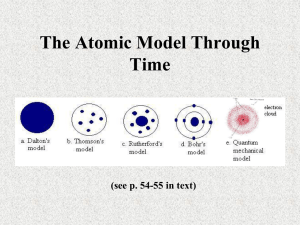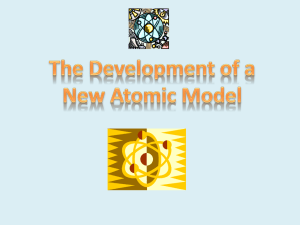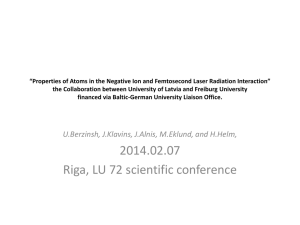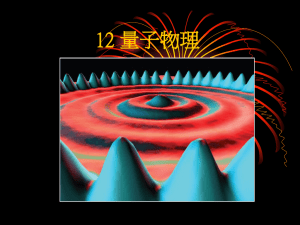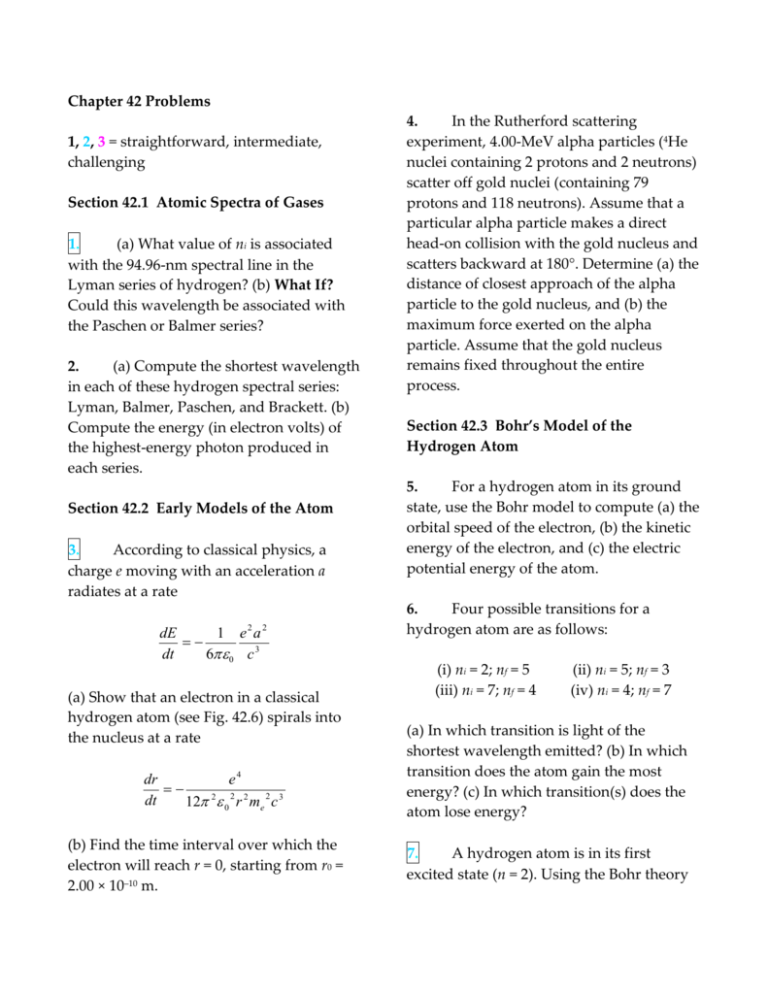
Chapter 42 Problems
1, 2, 3 = straightforward, intermediate,
challenging
Section 42.1 Atomic Spectra of Gases
1.
(a) What value of ni is associated
with the 94.96-nm spectral line in the
Lyman series of hydrogen? (b) What If?
Could this wavelength be associated with
the Paschen or Balmer series?
2.
(a) Compute the shortest wavelength
in each of these hydrogen spectral series:
Lyman, Balmer, Paschen, and Brackett. (b)
Compute the energy (in electron volts) of
the highest-energy photon produced in
each series.
Section 42.2 Early Models of the Atom
3.
According to classical physics, a
charge e moving with an acceleration a
radiates at a rate
2
dE
1 e a
dt
60 c 3
2
(a) Show that an electron in a classical
hydrogen atom (see Fig. 42.6) spirals into
the nucleus at a rate
dr
e4
2
2
dt
12 2 0 r 2 me c 3
(b) Find the time interval over which the
electron will reach r = 0, starting from r0 =
2.00 × 10–10 m.
4.
In the Rutherford scattering
experiment, 4.00-MeV alpha particles (4He
nuclei containing 2 protons and 2 neutrons)
scatter off gold nuclei (containing 79
protons and 118 neutrons). Assume that a
particular alpha particle makes a direct
head-on collision with the gold nucleus and
scatters backward at 180°. Determine (a) the
distance of closest approach of the alpha
particle to the gold nucleus, and (b) the
maximum force exerted on the alpha
particle. Assume that the gold nucleus
remains fixed throughout the entire
process.
Section 42.3 Bohr’s Model of the
Hydrogen Atom
5.
For a hydrogen atom in its ground
state, use the Bohr model to compute (a) the
orbital speed of the electron, (b) the kinetic
energy of the electron, and (c) the electric
potential energy of the atom.
6.
Four possible transitions for a
hydrogen atom are as follows:
(i) ni = 2; nf = 5
(iii) ni = 7; nf = 4
(ii) ni = 5; nf = 3
(iv) ni = 4; nf = 7
(a) In which transition is light of the
shortest wavelength emitted? (b) In which
transition does the atom gain the most
energy? (c) In which transition(s) does the
atom lose energy?
7.
A hydrogen atom is in its first
excited state (n = 2). Using the Bohr theory
of the atom, calculate (a) the radius of the
orbit, (b) the linear momentum of the
electron, (c) the angular momentum of the
electron, (d) the kinetic energy of the
electron, (e) the potential energy of the
system, and (f) the total energy of the
system.
8.
How much energy is required to
ionize hydrogen (a) when it is in the
ground state? (b) when it is in the state for
which n = 3?
9.
A photon is emitted as a hydrogen
atom undergoes a transition from the n = 6
state to the n = 2 state. Calculate (a) the
energy, (b) the wavelength, and (c) the
frequency of the emitted photon.
10.
Show that the speed of the electron
in the nth Bohr orbit in hydrogen is given
by
vn
kee 2
n
11.
Two hydrogen atoms collide headon and end up with zero kinetic energy.
Each atom then emits light with a
wavelength of 121.6 nm (n = 2 to n = 1
transition). At what speed were the atoms
moving before the collision?
12.
A monochromatic beam of light is
absorbed by a collection of ground-state
hydrogen atoms in such a way that six
different wavelengths are observed when
the hydrogen relaxes back to the ground
state. What is the wavelength of the
incident beam?
13.
(a) Construct an energy-level
diagram for the He+ ion, for which Z = 2. (b)
What is the ionization energy for He+?
14.
In a hot star, because of the high
temperature, an atom can absorb sufficient
energy to remove several electrons from the
atom. Consider such a multiply ionized
atom with a single remaining electron. The
ion produces a series of spectral lines as
described by the Bohr model. The series
corresponds to electronic transitions that
terminate in the same final state. The
longest and shortest wavelengths of the
series are 63.3 nm and 22.8 nm,
respectively. (a) What is the ion? (b) Find
the wavelengths of the next three spectral
lines nearest to the line of longest
wavelength.
15.
(a) Calculate the angular momentum
of the Moon due to its orbital motion about
the Earth. In your calculation, use 3.84 × 108
m as the average Earth–Moon distance and
2.36 × 106 s as the period of the Moon in its
orbit. (b) Assume the Moon’s angular
momentum is described by Bohr’s
assumption mvr = nħ. Determine the
corresponding quantum number. (c) By
what fraction would the Earth–Moon
distance have to be increased to raise the
quantum number by 1?
Section 42.4 The Quantum Model of the
Hydrogen Atom
16.
A general expression for the energy
levels of one-electron atoms and ions is
En
r and the resulting total energy. Compare
your answer with the predictions of the
Bohr theory.
k e 2 q1 2 q 2 2
2 2 n 2
where ke is the Coulomb constant, q1 and q2
are the charges of the electron and the
nucleus, and μ is the reduced mass, given
by μ = m1m2/(m1 + m2). The wavelength for
the n = 3 to n = 2 transition of the hydrogen
atom is 656.3 nm (visible red light). What
If? What are the wavelengths for this same
transition in (a) positronium, which consists
of an electron and a positron, and (b) singly
ionized helium? (Note: A positron is a
positively charged electron.)
17.
An electron of momentum p is at a
distance r from a stationary proton. The
electron has kinetic energy K = p2/2me . The
atom has potential energy U = –kee2/r, and
total energy E = K + U. If the electron is
bound to the proton to form a hydrogen
atom, its average position is at the proton,
but the uncertainty in its position is
approximately equal to the radius r of its
orbit. The electron’s average vector
momentum is zero, but its average squared
momentum is approximately equal to the
squared uncertainty in its momentum, as
given by the uncertainty principle. Treating
the atom as a one-dimensional system, (a)
estimate the uncertainty in the electron’s
momentum in terms of r. (b) Estimate the
electron’s kinetic, potential, and total
energies in terms of r. (c) The actual value
of r is the one that minimizes the total energy,
resulting in a stable atom. Find that value of
Section 42.5 The Wave Functions for
Hydrogen
18.
Plot the wave function ψ1s(r) (see Eq.
42.22) and the radial probability density
function P1s(r) (see Eq. 42.25) for hydrogen.
Let r range from 0 to 1.5a0, where a0 is the
Bohr radius.
19.
The ground-state wave function for
the electron in a hydrogen atom is
r
1
a0
3
e r / a0
where r is the radial coordinate of the
electron and a0 is the Bohr radius. (a) Show
that the wave function as given is
normalized. (b) Find the probability of
locating the electron between r1 = a0/2 and r2
= 3a0/2.
20.
The wave function for an electron in
the 2p state of hydrogen is
2p
1
3 2a0
3/ 2
r r / 2 a0
e
a0
What is the most likely distance from the
nucleus to find an electron in the 2p state?
21.
For a spherically symmetric state of a
hydrogen atom, the Schrödinger equation
in spherical coordinates is
2 d 2 2 d k e e 2
E
2m dr 2 r dr
r
Show that the 1s wave function for an
electron in hydrogen,
r
1
a0
3
e r / a0
satisfies the Schrödinger equation.
22.
In an experiment, electrons are fired
at a sample of neutral hydrogen atoms and
observations are made of how the incident
particles scatter. A large set of trials can be
thought of as containing 1 000 observations
of the electron in the ground state of a
hydrogen atom being momentarily at a
distance a0/2 from the nucleus. How many
times is the atomic electron observed at a
distance 2a0 from the nucleus in this set of
trials?
Section 42.6 Physical Interpretation of the
Quantum Numbers
23.
List the possible sets of quantum
numbers for electrons in (a) the 3d subshell
and (b) the 3p subshell.
26.
A hydrogen atom is in its fifth
excited state, with principal quantum
number 6. The atom emits a photon with a
wavelength of 1 090 nm. Determine the
maximum possible orbital angular
momentum of the electron after emission.
27.
How many sets of quantum numbers
are possible for an electron for which (a) n =
1, (b) n = 2, (c) n = 3, (d) n = 4, and (e) n = 5?
Check your results to show that they agree
with the general rule that the number of
sets of quantum numbers for a shell is equal
to 2n2.
28.
Find all possible values of L, Lz, and
θ for an electron in a 3d state of hydrogen.
29.
(a) Find the mass density of a proton,
modeling it as a solid sphere of radius 1.00
× 10–15 m. (b) What If? Consider a classical
model of an electron as a solid sphere with
the same density as the proton. Find its
radius. (c) Imagine that this electron
possesses spin angular momentum Iω = ħ/2
because of classical rotation about the z
axis. Determine the speed of a point on the
equator of the electron and (d) compare this
speed to the speed of light.
24.
Calculate the angular momentum for
an electron in (a) the 4d state and (b) the 6f
state.
30.
An electron is in the N shell.
Determine the maximum value the z
component of its angular momentum could
have.
25.
If an electron has orbital angular
momentum equal to 4.714 × 10–34 J · s, what
is the orbital quantum number for the state
of the electron?
31.
The ρ-meson has a charge of –e, a
spin quantum number of 1, and a mass
1 507 times that of the electron. What If?
Imagine that the electrons in atoms were
replaced by ρ-mesons. List the possible sets
of quantum numbers for ρ-mesons in the 3d
subshell.
Section 42.7 The Exclusion Principle and
the Periodic Table
32.
(a) Write out the electronic
configuration for the ground state of
oxygen (Z = 8). (b) Write out a set of
possible values for the quantum numbers n,
ℓ, m ℓ, and ms for each electron in oxygen.
33.
As we go down the periodic table,
which subshell is filled first, the 3d or the 4s
subshell? Which electronic configuration
has a lower energy: [Ar]3d44s2 or [Ar]3d54s1?
Which has the greater number of unpaired
spins? Identify this element and discuss
Hund’s rule in this case. (Note: The notation
[Ar] represents the filled configuration for
argon.)
34.
Devise a table similar to that shown
in Figure 42.19 for atoms containing 11
through 19 electrons. Use Hund’s rule and
educated guesswork.
35.
A certain element has its outermost
electron in a 3p state. It has valence +3, since
it has 3 more electrons than a certain noble
gas. What element is it?
36.
Two electrons in the same atom both
have n = 3 and ℓ = 1. (a) List the quantum
numbers for the possible states of the atom.
(b) What If? How many states would be
possible if the exclusion principle were
inoperative?
37.
(a) Scanning through Table 42.4 in
order of increasing atomic number, note
that the electrons fill the subshells in such a
way that those subshells with the lowest
values of n + ℓ are filled first. If two
subshells have the same value of n + ℓ, the
one with the lower value of n is filled first.
Using these two rules, write the order in
which the subshells are filled through n + ℓ
= 7. (b) Predict the chemical valence for the
elements that have atomic numbers 15, 47,
and 86, and compare your predictions with
the actual valences (which may be found in
a chemistry text).
38.
For a neutral atom of element 110,
what would be the probable ground-state
electronic configuration?
39.
Review problem. For an electron
with magnetic moment μS in a magnetic
field B, Section 29.3 showed the following.
The electron can be in a higher energy state
with the z component of its magnetic
moment opposite to the field, or in a lower
energy state with the z component of its
magnetic moment in the direction of the
field. The difference in energy between the
two states is 2μBB. Under high resolution,
many spectral lines are observed to be
doublets. The most famous of these are the
two yellow lines in the spectrum of sodium
(the D lines), with wavelengths of 588.995
nm and 589.592 nm. Their existence was
explained in 1925 by Goudsmit and
Uhlenbeck, who postulated that an electron
has intrinsic spin angular momentum.
When the sodium atom is excited with its
outermost electron in a 3p state, the orbital
motion of the outermost electron creates a
magnetic field. The atom’s energy is
somewhat different depending on whether
the electron is itself spin-up or spin-down
in this field. Then the photon energy the
atom radiates as it falls back into its ground
state depends on the energy of the excited
state. Calculate the magnitude of the
internal magnetic field mediating this socalled spin-orbit coupling.
Section 42.8 More on Atomic Spectra:
Visible and X-Ray
40.
(a) Determine the possible values of
the quantum numbers ℓ and mℓ for the He+
ion in the state corresponding to n = 3. (b)
What is the energy of this state?
41.
If you wish to produce 10.0-nm xrays in the laboratory, what is the
minimum voltage you must use in
accelerating the electrons?
42. In x-ray production, electrons are
accelerated through a high voltage ΔV and
then decelerated by striking a target. Show
that the shortest wavelength of an x-ray
that can be produced is
λ min
44.
The K series of the discrete x-ray
spectrum of tungsten contains wavelengths
of 0.018 5 nm, 0.020 9 nm, and 0.021 5 nm.
The K-shell ionization energy is 69.5 keV.
Determine the ionization energies of the L,
M, and N shells. Draw a diagram of the
transitions.
45.
The wavelength of characteristic xrays in the Kβ line is 0.152 nm. Determine
the material in the target.
Section 42.9 Spontaneous and Stimulated
Transitions
Section 42.10 Lasers
46.
Figure P42.46 shows portions of the
energy-level diagrams of the helium and
neon atoms. An electrical discharge excites
the He atom from its ground state to its
excited state of 20.61 eV. The excited He
atom collides with a Ne atom in its ground
state and excites this atom to the state at
20.66 eV. Lasing action takes place for
electron transitions from E3* to E2 in the Ne
atoms. From the data in the figure, show
that the wavelength of the red He–Ne laser
light is approximately 633 nm.
1240 nm V
ΔV
43.
Use the method illustrated in
Example 42.9 to calculate the wavelength of
the x-ray emitted from a molybdenum
target (Z = 42) when an electron moves
from the L shell (n = 2) to the K shell (n = 1).
Figure P42.46
47.
The carbon dioxide laser is one of the
most powerful developed. The energy
difference between the two laser levels is
0.117 eV. Determine the frequency and
wavelength of the radiation emitted by this
laser. In what portion of the
electromagnetic spectrum is this radiation?
48.
A Nd:YAG laser used in eye surgery
emits a 3.00-mJ pulse in 1.00 ns, focused to
a spot 30.0 μm in diameter on the retina. (a)
Find (in SI units) the power per unit area at
the retina. (This quantity is called the
irradiance in the optics industry.) (b) What
energy is delivered to an area of molecular
size, taken as a circular area 0.600 nm in
diameter?
49.
A ruby laser delivers a 10.0-ns pulse
of 1.00 MW average power. If the photons
have a wavelength of 694.3 nm, how many
are contained in the pulse?
50.
The number N of atoms in a
particular state is called the population of
that state. This number depends on the
energy of that state and the temperature. In
thermal equilibrium the population of
atoms in a state of energy En is given by a
Boltzmann distribution expression
where T is the absolute temperature and Ng
is the population of the ground state, of
energy Eg. For simplicity, we assume that
each energy level has only one quantum
state associated with it. (a) Before the
power is switched on, the neon atoms in a
laser are in thermal equilibrium at 27.0°C.
Find the equilibrium ratio of the
populations of the states E3* and E2 shown
in Figure 42.28. Lasers operate by a clever
artificial production of a “population
inversion” between the upper and lower
atomic energy states involved in the lasing
transition. This means that more atoms are
in the upper excited state then in the lower
one. Consider the helium–neon laser
transition at 632.8 nm. Assume that 2%
more atoms occur in the upper state than in
the lower. (b) To demonstrate how
unnatural such a situation is, find the
temperature for which the Boltzmann
distribution describes a 2.00% population
inversion. (c) Why does such a situation not
occur naturally?
51.
Review problem. A helium–neon
laser can produce a green laser beam
instead of red. Refer to Figure 42.28, which
omits some energy levels between E2 and
E1. After a population inversion is
established, neon atoms will make a variety
of downward transitions in falling from the
state labeled E3* down eventually to level
E1. The atoms will emit both red light with
a wavelength of 632.8 nm and also green
light with a wavelength of 543 nm in a
competing transition. Assume the atoms
are in a cavity between mirrors designed to
reflect the green light with high efficiency
but to allow the red light to leave the cavity
immediately. Then stimulated emission can
lead to the buildup of a collimated beam of
green light between the mirrors having a
greater intensity than does the red light. A
small fraction of the green light is permitted
to escape by transmission through one
mirror, to constitute the radiated laser
beam. The mirrors forming the resonant
cavity can be made of layers of silicon
dioxide and titanium dioxide. (a) How
thick a layer of silicon dioxide, between
layers of titanium dioxide, would minimize
reflection of the red light? (b) What should
be the thickness of a similar but separate
layer of silicon dioxide to maximize
reflection of the green light?
Additional Problems
52.
As the Earth moves around the Sun,
its orbits are quantized. (a) Follow the steps
of Bohr’s analysis of the hydrogen atom to
show that the allowed radii of the Earth’s
orbit are given by
r
n2 2
GM S M E
2
where MS is the mass of the Sun, ME is the
mass of the Earth, and n is an integer
quantum number. (b) Calculate the
numerical value of n. (c) Find the distance
between the orbit for quantum number n
and the next orbit out from the Sun
corresponding to the quantum number n +
1. Discuss the significance of your results.
53.
LENINGRAD, 1930—Four years
after publication of the Schrödinger
equation, Lev Davidovich Landau, age 23,
solved the equation for a charged particle
moving in a uniform magnetic field. A
single electron moving perpendicular to a
field B can be considered as a model atom
without a nucleus, or as the irreducible
quantum limit of the cyclotron. Landau
proved that its energy is quantized in
uniform steps of eħB/me. HARVARD,
1999—Gerald Gabrielse traps a single
electron in an evacuated centimeter-size
metal can cooled to a temperature of 80 mK.
In a magnetic field of magnitude 5.26 T, the
electron circulates for hours in its lowest
energy level, generating a measurable
signal as it moves. (a) Evaluate the size of a
quantum jump in the electron’s energy. (b)
For comparison, evaluate kBT as a measure
of the energy available to the electron in
blackbody radiation from the walls of its
container. (c) Microwave radiation can be
introduced to excite the electron. Calculate
the frequency and wavelength of the
photon that the electron absorbs as it jumps
to its second energy level. Measurement of
the resonant absorption frequency verifies
the theory and permits precise
determination of properties of the electron.
54.
Example 42.4 calculates the most
probable value and the average value for
the radial coordinate r of the electron in the
ground state of a hydrogen atom. What If?
For comparison with these modal and mean
values, find the median value of r. Proceed
as follows. (a) Derive an expression for the
probability, as a function of r, that the
electron in the ground state of hydrogen
will be found outside a sphere of radius r
centered on the nucleus. (b) Make a graph
of the probability as a function of r/a0.
Choose values of r/a0 ranging from 0 to 4.00
in steps of 0.250. (c) Find the value of r for
which the probability of finding the
electron outside a sphere of radius r is
equal to the probability of finding the
electron inside this sphere. You must solve
a transcendental equation numerically, and
your graph is a good starting point.
frequency, note that the frequency of
revolution is v/2πr, where r is given by Eq.
42.10.)
55.
The positron is the antiparticle to the
electron. It has the same mass and a
positive electric charge of the same
magnitude as that of the electron.
Positronium is a hydrogen-like atom
consisting of a positron and an electron
revolving around each other. Using the
Bohr model, find the allowed distances
between the two particles and the allowed
energies of the system.
58.
Astronomers observe a series of
spectral lines in the light from a distant
galaxy. On the hypothesis that the lines
form the Lyman series for a (new?) oneelectron atom, they start to construct the
energy-level diagram shown in Figure
P42.58, which gives the wavelengths of the
first four lines and the short-wavelength
limit of this series. Based on this
information, calculate (a) the energies of the
ground state and first four excited states for
this one-electron atom, and (b) the
wavelengths of the first three lines and the
shortwavelength limit in the Balmer series
for this atom. (c) Show that the wavelengths
of the first four lines and the short
wavelength limit of the Lyman series for
the hydrogen atom are all 60.0% of the
wavelengths for the Lyman series in the
one-electron atom described in part (b). (d)
Based on this observation, explain why this
atom could be hydrogen.
56.
Review problem. (a) How much
energy is required to cause an electron in
hydrogen to move from the n = 1 state to
the n = 2 state? (b) Suppose the electron
gains this energy through collisions among
hydrogen atoms at a high temperature. At
what temperature would the average
atomic kinetic energy 3kBT/2, where kB is the
Boltzmann constant, be great enough to
excite the electron?
57.
An example of the correspondence
principle. Use Bohr’s model of the hydrogen
atom to show that when the electron moves
from the state n to the state n – 1, the
frequency of the emitted light is
2 2 me k e 2 e 4 2n 1
f
3 2
n 12
h
n
Show that as n ∞, this expression varies
as 1/n3 and reduces to the classical
frequency one expects the atom to emit.
(Suggestion: To calculate the classical
of the pulse as it travels through space and
(b) the number of photons in it. (c) The
beam has a circular cross section of
diameter 0.600 cm. Find the number of
photons per cubic millimeter.
62.
A pulsed laser emits light of
wavelength λ. For a pulse of duration Δt
having energy E, find (a) the physical
length of the pulse as it travels through
space and (b) the number of photons in it.
(c) The beam has a circular cross section
having diameter d. Find the number of
photons per unit volume.
Figure P42.58
59.
Suppose a hydrogen atom is in the 2s
state, with its wave function given by
Equation 42.26. Taking r = a0, calculate
values for (a) ψ2s(a0), (b) 2 s a 0 , and (c)
2
P2s(a0).
60.
The states of matter are solid, liquid,
gas, and plasma. Plasma can be described
as a gas of charged particles, or a gas of
ionized atoms. Most of the matter in the
Solar System is plasma (throughout the
interior of the Sun). In fact, most of the
matter in the Universe is plasma; so is a
candle flame. Use the information in Figure
42.20 to make an order-of-magnitude
estimate for the temperature to which a
typical chemical element must be raised to
turn into plasma by ionizing most of the
atoms in a sample. Explain your reasoning.
61.
A pulsed ruby laser emits light at
694.3 nm. For a 14.0-ps pulse containing
3.00 J of energy, find (a) the physical length
63.
Assume that three identical
uncharged particles of mass m and spin 1/2
are contained in a one-dimensional box of
length L. What is the ground-state energy of
this system?
64.
The force on a magnetic moment μz
in a nonuniform magnetic field Bz is given
by Fz = μz(dBz/dz). If a beam of silver atoms
travels a horizontal distance of 1.00 m
through such a field and each atom has a
speed of 100 m/s, how strong must be the
field gradient dBz/dz in order to deflect the
beam 1.00 mm?
65.
(a) Show that the most probable
radial position for an electron in the 2s state
of hydrogen is r = 5.236a0. (b) Show that the
wave function given by Equation 42.26 is
normalized.
66.
Suppose the ionization energy of an
atom is 4.10 eV. In the spectrum of this
same atom, we observe emission lines with
wavelengths 310 nm, 400 nm, and 1 377.8
nm. Use this information to construct the
energy-level diagram with the fewest
levels. Assume that the higher levels are
closer together.
67.
An electron in chromium moves
from the n = 2 state to the n = 1 state
without emitting a photon. Instead, the
excess energy is transferred to an outer
electron (one in the n = 4 state), which is
then ejected by the atom. (This is called an
Auger [pronounced ‘ohjay’] process, and
the ejected electron is referred to as an
Auger electron.) Use the Bohr theory to find
the kinetic energy of the Auger electron.
68.
In interstellar space, atomic
hydrogen produces the sharp spectral line
called the 21-cm radiation, which
astronomers find most helpful in detecting
clouds of hydrogen between stars. This
radiation is useful because it is the only
signal cold hydrogen emits and because
interstellar dust that obscures visible light
is transparent to these radio waves. The
radiation is not generated by an electron
transition between energy states
characterized by different values of n.
Instead, in the ground state (n = 1), the
electron and proton spins may be parallel
or antiparallel, with a resultant slight
difference in these energy states. (a) Which
condition has the higher energy? (b) More
precisely, the line has wavelength 21.11 cm.
What is the energy difference between the
states? (c) The average lifetime in the
excited state is about 107 yr. Calculate the
associated uncertainty in energy of the
excited energy level.
69.
For hydrogen in the 1s state, what is
the probability of finding the electron
farther than 2.50a0 from the nucleus?
70.
All atoms have the same size, to an
order of magnitude. (a) To show this,
estimate the diameters for aluminum (with
molar mass 27.0 g/mol and density 2.70
g/cm3) and uranium (molar mass 238 g/mol
and density 18.9 g/cm3). (b) What do the
results imply about the wave functions for
inner-shell electrons as we progress to
higher and higher atomic mass atoms?
(Suggestion: The molar volume is
approximately D3NA, where D is the atomic
diameter and NA is Avogadro’s number.)
71.
In the technique known as electron
spin resonance (ESR), a sample containing
unpaired electrons is placed in a magnetic
field. Consider the simplest situation, in
which only one electron is present and
therefore only two energy states are
possible, corresponding to ms = ± ½. In ESR,
the absorption of a photon causes the
electron’s spin magnetic moment to flip
from the lower energy state to the higher
energy state. According to Section 29.3, the
change in energy is 2μBB. (The lower energy
state corresponds to the case where the z
component of the magnetic moment μspin is
aligned with the magnetic field, and the
higher energy state is the case where the z
component of μspin is aligned opposite to the
field.) What is the photon frequency
required to excite an ESR transition in a
0.350-T magnetic field?
72.
Show that the wave function for an
electron in the 2s state in hydrogen
1
2 s r
4 2 a 0
1
3/ 2
r
2 e r / 2 a0
a0
satisfies the spherically symmetric
Schrödinger equation given in Problem 21.
73.
Review problem. Steven Chu,
Claude Cohen-Tannoudji, and William
Phillips received the 1997 Nobel Prize in
physics for “the development of methods to
cool and trap atoms with laser light.” One
part of their work was with a beam of
atoms (mass ~10–25 kg) that move at a speed
on the order of 1 km/s, similar to the speed
of molecules in air at room temperature. An
intense laser light beam tuned to a visible
atomic transition (assume 500 nm) is
directed straight into the atomic beam. That
is, the atomic beam and light beam are
traveling in opposite directions. An atom in
© Copyright 2004 Thomson. All rights reserved.
the ground state immediately absorbs a
photon. Total system momentum is
conserved in the absorption process. After a
lifetime on the order of 10–8 s, the excited
atom radiates by spontaneous emission. It
has an equal probability of emitting a
photon in any direction. Thus, the average
“recoil” of the atom is zero over many
absorption and emission cycles. (a)
Estimate the average deceleration of the
atomic beam. (b) What is the order of
magnitude of the distance over which the
atoms in the beam will be brought to a halt?
74.
Find the average (expectation) value
of 1/r in the 1s state of hydrogen. It is given
by
1/ r
1 / r dV Pr 1 / r 4
2
0
all space
Is the result equal to the inverse of the
average value of r?



